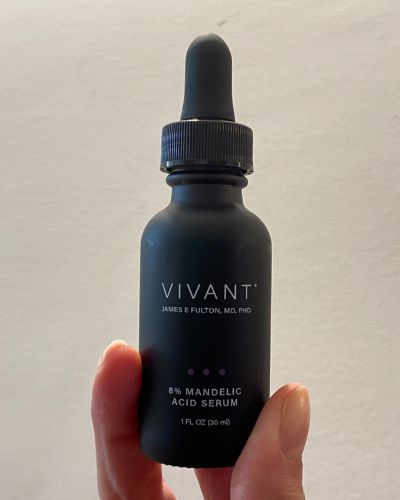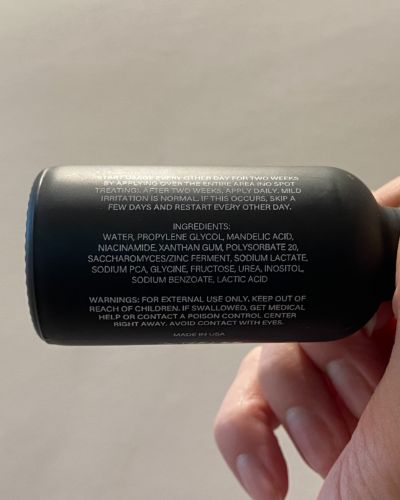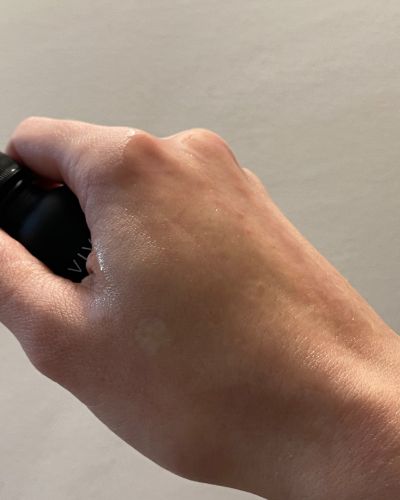Vivant Skin Care is a professional skincare line formulated by Dr. James Fulton, a dermatologist and medical researcher who co-founded Retin-A, the world’s most effective topical treatment for acne and skin aging.
The line, which is widely available through estheticians, focuses on skin concerns such as acne, aging, and hyperpigmentation and offers a variety of products containing mandelic acid, benzoyl peroxide, and vitamin A derivatives.
One of their most popular products is their 8% Mandelic Acid 3-in-1 Serum, which I have previously featured in my articles, and I am finally reviewing today after using it for around six months at the time of writing this article.
So, without further ado, here’s my review of the Vivant Skin Care 8% Mandelic Acid Serum, where I will explain how this product worked for my oily, acne-prone skin and what are some things you should know before trying it out.
What is The Vivant Skin Care 8% Mandelic Acid Serum?

The Vivant Skin Care 8% Mandelic Acid Serum is a highly effective serum designed to combat acne and reduce hyperpigmentation and signs of aging.
It works by exfoliating the skin, clearing out debris from pores, reducing inflammation, and brightening the complexion.
It also helps control oil production and targets hyperpigmentation for an even skin tone.
Finally, the serum also contains hydrating ingredients that help keep the skin moisturized and plump and promote a youthful appearance.
Ingredients

The 8% Mandelic Acid Serum can only be described as a beautiful assortment of anti-acne, hydrating, and skin-nourishing ingredients.
One thing I love about this serum is that it only contains goodies that get right to work and target multiple skin concerns other than acne.
Starting off, we have the main active ingredient, mandelic acid, an anti-inflammatory exfoliating acid that dissolves cellular debris inside the pores to soothe inflammation and reduce the appearance of acne.
Next on the list is niacinamide, a brightening and barrier-strengthening antioxidant that targets the overproduction of melanin to minimize post-inflammatory hyperpigmentation and even out the skin tone.
Additionally, the serum also contains various hydrating components, including sodium PCA, glycine, and urea, a powerful humectant naturally found in our skin that draws and holds water in the skin, keeping it hydrated and plump while helping to reduce visible signs of aging.
Finally, the 8% Mandelic Acid Serum also contains a mild concentration of lactic acid, a nourishing exfoliant that smooths out the skin’s surface by gently buffing away dead skin cells to reveal a brighter, smoother and more even complexion from underneath.
This combination of ingredients is definitely what makes the 8% Mandelic Acid Serum a truly unique player in its own right when it comes to addressing various skin concerns, from acne to hyperpigmentation and a rough, dry, and textured appearance.
Scent
The 8% Mandelic Acid Serum has a slight medicinal scent to it.
If you have used the Paula’s Choice 2% BHA Liquid, this is probably the closest product to which the scent can be compared.
That said, the 8% Mandelic Acid Serum doesn’t contain fragrance or fragrant components such as essential oils, which makes it suitable for sensitive, reactive, and allergy-prone skin.
Consistency

The 8% Mandelic Acid Serum has a clear, watery consistency that absorbs quickly into the skin and leaves a semi-matte finish once fully settled.
I have seen some reviewers say that the serum left a slightly “tacky” feeling to the skin; however, I have noticed this to be the case whenever I applied more than necessary.
So, when using the 8% Mandelic Acid Serum, remember that less is more. You’ve likely used too much if the product leaves a tacky sensation or appears wet and shiny after 2-3 minutes.
Vivant Skin Care 8% Mandelic Acid Serum Performance & Results

I have very oily skin that’s highly prone to clogging and acne; however, I am not currently dealing with sensitivities or active breakouts because I have a set routine that works for me, so I started using the 8% Mandelic Acid Serum on clear and balanced skin.
However, while I don’t have active inflammation, I do have post-inflammatory erythema or red spots on my cheeks from dealing with acne in my early twenties.
These red spots take a long time to heal and can even remain on the skin longer than post-inflammatory hyperpigmentation or dark spots.
Therefore, before using the 8% Mandelic Acid Serum, I was on the hunt for products that would help me improve this concern.
Now, I started using the 8% Mandelic Acid Serum twice a week, in the evenings, on clean, dry skin.
I initially experienced flaking around my mouth, which typically showed on the second morning (around 36 hours) after applying the serum.
However, despite this mild inconvenience, I didn’t experience any purging, redness, or irritation, and the mild flaking was the only side effect that occurred while my skin was getting used to the serum.
This is a major concern for many people; however, it’s also important to remember that side effects like purging, redness, and irritation typically occur when the skin barrier is compromised.
On the other hand, if your skin barrier is strong and healthy, this means it won’t freak out as easily when exposed to a new product, and you will have an easier and less uncomfortable introduction to an exfoliating product.
This is also why I don’t recommend exfoliating more than 2-3 times a week, especially when introducing a new exfoliating product to your routine, as it can lead to over-exfoliation and barrier damage, which will delay the healing of acne.
But back to my review: At the time of writing, I had been diligently using the 8% Mandelic Acid Serum for around six months.
During this time, my skin got used to the product, and after the first two or three weeks, I no longer experienced any flaking.
Additionally, I have noticed a significant reduction in the post-inflammatory red spots on my cheeks, and although I still notice some redness throughout the day, comparing this to old photos where my redness was more severe, I can definitely see a difference.
Furthermore, the 8% Mandelic Acid Serum not only helped even out my skin tone and reduce post-inflammatory redness, but it also made my skin smoother, plumper, and softer and even helped erase a few fine lines on my forehead.
Finally, since I am not immune to acne and tend to get rogue pimples now and again, I have noticed that even large, inflamed spots seem to heal or significantly reduce in size by the following day after using the 8% Mandelic Acid Serum the previous night.
Therefore, while this serum was a fantastic addition to my skincare routine that focuses on maintaining my clear skin and targeting acne scarring, I am confident that it will benefit anyone dealing with concerns similar to mine and active acne.
With that said, I highly recommend trying out this serum for yourself if you are dealing with acne, post-inflammatory hyperpigmentation, scarring, uneven skin tone, and skin texture.
Where to Buy The Vivant 8% Mandelic Acid Serum?
Vivant is a popular brand among estheticians in the US and can be purchased from any professional that carries the line.
Additionally, their products are also available to US customers through their official website.
On the other hand, if you are in Europe, you can purchase Vivant products by contacting Allure Beauty, an aesthetic salon based in Ukraine that can send you any Vivant products after having a consultation with their professionals.
Frequently Asked Questions
How Long Does it Take for Mandelic Acid to Clear Acne?
Mandelic acid begins to clear acne within one to two weeks for some people, but most individuals start seeing results after about a month of use.
However, consistent use for at least eight to twelve weeks is recommended for a full transformation and a noticeable reduction in acne breakouts.
Does Mandelic Acid Help Hormonal Acne?
Mandelic acid can be beneficial for hormonal acne as it promotes cell regeneration, has antibacterial properties, and regulates sebum production, all of which help control breakouts.
However, it’s worth noting that while mandelic acid can help manage the skin-related symptoms of hormonal imbalances, it won’t address the underlying cause.
Therefore, a combination of topical treatments, lifestyle modifications, and possibly hormonal therapy may be needed for optimal results when it comes to treating hormonal acne.
What Not to Mix With Mandelic Acid?
Mandelic acid should not be mixed with other acids, such as glycolic acid, lactic acid, and salicylic acid, as this might cause over-exfoliation.
Additionally, it should be avoided in combination with direct forms of vitamin C and retinoids, as this could cause irritation.
However, this only applies if you use multiple products containing these active ingredients. On the other hand, if multiple actives are included in one product, it’s generally safe to use.
This is because the product has been formulated with a balance of strength percentages that work synergistically without causing skin irritation or over-exfoliation.

My name is Simone and I am a certified skin specialist. I created this website to teach my readers how to take great care of their skin and I also like to occasionally share my honest opinions on skincare products I’ve tried. You can learn more about me here.
